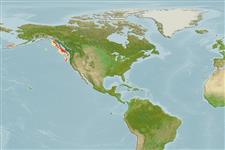Issue
The species was placed in the genus Bathyphasma Gilbert, 1896 by Balushkin (2012), genus he resurrected on the basis of a few characters. He was followed by authors thereafter but with no supplementary evidence. Orr et al. (2019) did not support the resurrection from their phylogeny, on the basis of a lack or morphological synapomorphies with other sister-species, which we follow in FishBase and WoRMS. As Bathyphasma ovigerum Gilbert 1896 in ECoF (March 2024).
Environment: milieu / Klimaatzone / Diepte / distribution range
Ecologie
marien bathydemersaal; diepte 1920 - 2910 m (Ref. 6885). Deep-water
Northeast Pacific: off northern British Columbia. Occurrence record from Washington (Ref. 5515).
Grootte / Gewicht / Leeftijd
Maturiteit: Lm ? range ? - ? cm
Max length : 43.1 cm SL mannelijk / geslacht onbekend; (Ref. 12204)
Korte beschrijving
Determinatiesleutels | Morfologie | Morfometrie
Dorsale stekels (totaal) : 0; Dorsale zachte stralen (totaal) : 40 - 45; Anale stekels: 0; Anale zachte stralen: 35 - 36; Wervels: 45 - 50. This species is distinguished from its congeners by the following set of characters: both jaws with narrow rows of stout, sharp, simple, recurved teeth; a moderate-sized gill opening which extends ventrally to pectoral rays 4-8; pelvic disk large 25-38% HL; cephalic pore pattern 2-6-7-1; most similar to C. lycopersicus and C. kamikawai, which are both distinguished from C. ovigerus by their broad bands of trilobed teeth (Ref. 91047).
Body shape (shape guide): elongated.
The holotype, a male, was found to carry developing eggs in its mouth (Ref. 6885). Two females were ripe with large yolked eggs 6-7 mm in diameter, while the male of 33.0 cm SL had enlarged testes. Two smallest and immature females examined (18.0-18.5 cm SL) had small ovaries with many small white eggs ca. 1 mm in diameter (Ref. 91047).
Levenscyclus en paargedrag
Maturiteit | Voortplanting | Paaien | Eieren | Fecunditeit | Larven
McAllister, D.E., 1990. A list of the fishes of Canada. Syllogeus No. 64. Nat. Mus. Nat. Sci., Ottawa, Canada. 310 p. (Ref. 11980)
Status op de Rode Lijst van het IUCN (Ref. 130435: Version 2025-1)
Gevaar voor de mens
Harmless
Gebruik door de mens
Visserij: van geen belang
Tools
Speciale rapporten
Download XML
Internetbronnen
Estimates based on models
Preferred temperature (Ref.
123201): 1.7 - 1.9, mean 1.9 °C (based on 7 cells).
Fylogenetische diversiteitsindex (Ref.
82804): PD
50 = 0.5000 [Uniqueness, from 0.5 = low to 2.0 = high].
Bayesian length-weight: a=0.00457 (0.00208 - 0.01002), b=3.17 (2.99 - 3.35), in cm total length, based on LWR estimates for this Genus-body shape (Ref.
93245).
Trofisch niveau (Ref.
69278): 3.4 ±0.5 se; based on size and trophs of closest relatives
Weerstandsvermogen (Ref.
120179): Gemiddeld, minimale populatieverdubbelingstijd 1,4-4,4 jaar (Preliminary K or Fecundity.).
Fishing Vulnerability (Ref.
59153): Moderate vulnerability (41 of 100).
🛈
